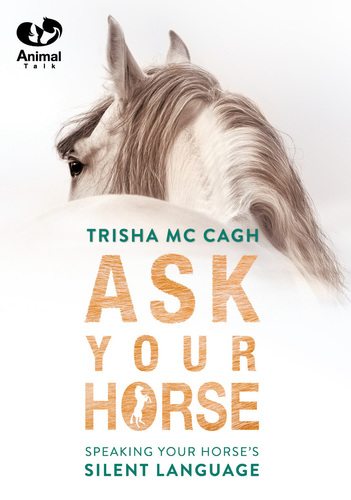No products in the cart.

[vc_row][vc_column][vc_column_text]I am sure you can’t wait to have a conversation with your horse to know what they are thinking and trying to tell you! So here is an excerpt from my book ‘Ask Your Horse’ to get you started.
Telepathic Communication Direct communication of mentally sending and receiving thoughts and feelings across a distance between your mind and your horses’s mind. These communications can occur in images, small videos running in your mind, or simply words.
Intuitive Communication Sensing emotions, impressions, sensations or just pure knowing from the energy of your equine companion. Just being connected or in the presence of your horse can begin this process.
In the early stages while practicing your skills you will be using the silent language (or telepathy), but once you feel confident, you can talk to your equine friend verbally and receive their response silently. You may also want to close your eyes with this next exercise as there are less distractions, or you can keep them open, it is up to you.
EXERCISE 1
- Using your telepathic and intuitive abilities, you are going to learn how to carry out some simple activities with your horse. For example, asking your horse to come to you from the paddock.
- Even if your horse readily comes to you when you call them, still try doing this exercise. Using their silent language will take you to deeper levels of interaction and enthusiasm with your horse.
- Stand a short distance away from the gate to your horse’s paddock. By not entering the paddock, you will be able to see your horse but your presence will not be invading their territory or evoking an immediate response from them.
Take a few moments to quieten your mind by taking a few deep breaths, allowing both your mind and body to relax.
If your horse/s have noticed you, wait until they have returned to grazing and are ignoring your presence completely. Now, in your mind, visualise your horse’s face while mentally calling their name. Then, visualise what your horse would look like walking towards you. You can have your eyes open or closed for this exercise.[/vc_column_text][vc_row_inner][vc_column_inner width=”1/3″][us_single_image image=”7883″ size=”full” align=”center”][/vc_column_inner][vc_column_inner width=”2/3″][vc_column_text]If you found it easier with your eyes closed, open them now and look to see if your horse is responding to your visualisation by walking towards you. Don’t be disheartened if your horse isn’t approaching; take note if they are staring at you or acting differently. As they won’t be used to you communicating with them in this way, they may be picking up on the communication but ending it unclear as to what you are requesting. Remember, it takes practice to achieve clarity but even then, respect that your horse is not a robot and will not always automatically respond just because you want them to.
Horses enjoy this non-invasive way of communicating and appreciate your effort to speak with them in their language. With continued practice, you will and the channels of communication will open, the clarity of your conversation will improve, and your horse will begin to respond.
When your horse does respond, ensure you reward them with praise or a special treat – make it worth their while. Enjoy their company for a few minutes and then leave them alone. Your horse will then associate coming to you with a pleasant interaction, not something negative. Once you have done this several times you can begin incorporating other interactions, like walking to the arena or round yard. For now though, keep it simple and positive.
To view the book please click HERE[/vc_column_text][/vc_column_inner][/vc_row_inner][/vc_column][/vc_row]
